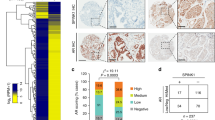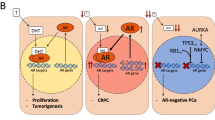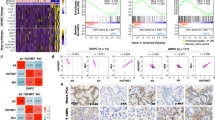Abstract
Current therapy for advanced prostate cancer is mainly based on androgen deprivation, although most patients relapse to androgen-insensitive disease. Several mechanisms contributing to androgen-independent growth including alterations in the structure or expression of the androgen receptor (AR) and its cofactors have been identified. Recent evidence suggests that p53 is involved in androgen signaling. The analysis of the effect of p53 on androgen signaling was performed in 22Rv1 and LNCaP prostate cancer cells that express both p53 and AR. The overexpression of p53 diminished the androgenic response in both cell lines in a reporter gene assay. Conversely, the inhibition of p53 by three different p53 inhibitors, Pifithrin-1α (PFT-1α), an inhibitor of p53-dependent transactivation; MDM2, a regulator of p53 expression; and a dominant-negative N-terminally truncated p53 gene also reduced transactivation of androgen-dependent reporter genes. The inactivation of p53 by PFT-1α decreased AR-protein expression in both 22Rv1 and LNCaP cells. Our findings confirm that the overexpression of wild-type p53 decreases androgen function, whereas p53 expression at physiological levels stabilizes AR signaling. Thus, our findings suggest that there is a balance of AR and p53 expression during the androgen-dependent growth of prostate cancer, which is obliterated during further progression of the disease.
This is a preview of subscription content, access via your institution
Access options
Subscribe to this journal
Receive 50 print issues and online access
$259.00 per year
only $5.18 per issue
Buy this article
- Purchase on Springer Link
- Instant access to full article PDF
Prices may be subject to local taxes which are calculated during checkout






Similar content being viewed by others
References
Agus DB, Cordon-Cardo C, Fox W, Drobnjak M, Koff A, Golde DW and Scher HI . (1999). J. Natl. Cancer Inst., 91, 1869–1876.
Aprikian AG, Sarkis AS, Fair WR, Zhang ZF, Fuks Z and Cordon-Cardo C . (1994). J. Urol., 151, 1276–1280.
Asschert JG, De Vries EG, De Jong S, Withoff S and Vellenga E . (1999). Int. J. Cancer, 81, 236–242.
Burchardt M, Burchardt T, Shabsigh A, Ghafar M, Chen MW, Anastasiadis A, de la Taille A, Kiss A and Buttyan R . (2001). Prostate, 48, 225–230.
Caleffi M, Teague MW, Jensen RA, Vnencak-Jones CL, Dupont WD and Parl FF . (1994). Cancer, 73, 2147–2155.
Carroll AG, Voeller HJ, Sugars L and Gelmann EP . (1993). Prostate, 23, 123–134.
Chen T, Wang LH and Farrar WL . (2000). Cancer Res., 60, 2132–2135.
Coffey RNT, Watson RWG, O’Neill AJ, Mc Eleny K and Fitzpatrick JM . (2002). Prostate, 53, 300–309.
Coursen JD, Bennett WP, Khan MA, Forrester K, Pietenpol JA and Harris CC . (1997). Mol. Carcinogen., 19, 191–203.
Culig Z, Bartsch G and Hobisch A . (2002). Mol. Cell. Endocrinol., 197, 231–238.
Culig Z, Hobisch A, Cronauer MV, Cato ACB, Hittmair A, Radmayr C, Eberle J, Bartsch G and Klocker H . (1993). Mol. Endocrinol., 7, 1541–1550.
Cronauer MV, Eder IE, Hittmair A, Sierek G, Hobisch A, Culig Z, Thurnher M, Bartsch G and Klocker H . (1997). In Vitro Cell Dev. Biol. Anim., 33, 742–744.
Cronauer MV, Nessler-Menardi C, Klocker H, Maly K, Hobisch A, Bartsch G and Culig Z . (2000). Br. J. Cancer, 82, 39–45.
Eastham JA, Grafton W, Martin CM and Williams BJ . (2000). J. Urol., 164, 814–819.
Eastham JA, Stapleton AM, Gousse AE, Timme TL, Yang G, Slawin KM, Wheeler TM, Scardino PT and Thompson TC . (1995). Clin. Cancer Res., 1, 1111–1118.
Feldman BJ and Feldman D . (2001). Nat. Rev., 1, 34–44.
Freedland SJ, Pantuk AJ, Paik SH, Zisman A, Graeber TG, Eisenberg D, McBride WH, Nguyen D, Tso C-L and Belldegrun AS . (2003). Prostate, 55, 299–307.
Grossman SR, Perez M, Kung AL, Joseph M, Mansur C, Xiao ZX, Kumar S and Howley PM . (1998). Mol. Cell, 2, 405–415.
Gurova KV, Roklin OW, Krivokrysenko VI, Chumakov PM, Cohen MB, Feinstein E and Gudkov AV . (2002). Oncogene, 2, 153–157.
Hasse A, Schulz WA and Siess H. . (1992). Biochem. Biophys. Acta, 1131, 16–22.
Heisler LE, Evangelou A, Lew AM, Trachtenberg J, Elsholtz HP and Brown TJ . (1997). Mol. Cell. Endocrinol., 126, 59–73.
Hobisch A, Eder IE, Putz T, Horninger W, Bartsch G, Klocker H and Culig Z . (1998). Cancer Res., 58, 4640–4645.
Isaacs WB, Carter BS and Ewing CM . (1991). Cancer Res., 51, 4716–4720.
Jacobberger JW, Sramkoski RM, Zhang D, Zumstein LA, Doerksen LD, Merritt JA, Wright SA and Shults KE . (1999). Cytometry, 38, 201–213.
Javelaud D and Besancon F . (2002). J. Biol. Chem., 277, 37949–37954.
Kelly KJ, Plotkin Z, Vulgamott SL and Dagher PC . (2003). J. Am. Soc. Nephrol., 14, 128–138.
Komarov PG, Komarova EA, Kondratov RV, Christov-Tselkov K, Coon JS, Chernov MV and Gudkov AV . (1999). Science, 285, 1733–1737.
Komarova EA, Neznanov N, Komarov PG, Chernov MV, Wang K and Gudkov A . (2003). J. Biol. Chem., 278, 15465–15468.
Kremenetskaya OS, Logacheva NP, Baryshnikov AY, Chumakov PM and Kopnin BP . (1997). Oncol. Res., 9, 155–166.
Lee YG, Korenchuk S, Lehr J, Whitney S, Vessela R and Pienta KJ . (2001). In Vivo, 15, 157–162.
Lin H-Y, Shih AI, Davis FB, Tang H-Y, Martino LJ, Bennett JA and Davis PJ . (2002a). J. Urol., 168, 748–755.
Lin H-K, Wang L, Hu Y-C, Altuwaijri S and Chang C . (2002b). EMBO J., 21, 4037–4048.
Makri D, Schulz WA, Grimm M-O, Clasen S, Bojar H and Schmitz-Dräger BJ . (1998). Int. J. Oncol., 12, 621–628.
Marth C, Müller-Holzner E, Greiter E, Cronauer MV, Zeimet AG, Doppler W, Eibl B, Hynes NE and Daxenbichler G . (1990). Cancer Res., 50, 7037–7041.
Meyers FJ, Gumerlock PH, Chi SG, Borchers H, Deitch AD and deVere White RW . (1998). Cancer, 83, 2534–2539.
Momand J, Zambetti GP, Olson DC, George D and Levine AJ . (1992). Cell, 69, 1237–1245.
Navone NM, Troncoso P, Pisters LL, Goodrow TL, Palmer JL, Nichols WW, von Eschenbach AC and Conti CJ . (1993). J. Natl. Cancer Inst., 85, 1657–1669.
Nesslinger NE, Shi X-B and deVere White RW . (2003). Cancer Res., 63, 2228–2233.
Osman I, Drobnjak M, Fazzari M, Ferrara J, Scher HI and Cordon-Cardo C . (1999). Clin. Cancer Res., 5, 2082–2088.
Patel BJ, Pantuck AJ, Zisman A, Tsui KH, Paik SH, Caliliw R, Sheriff S, Wu L, deKernion JB, Tso CL and Belldegrun AS . (2000). J. Urol., 164, 1420–1425.
Peehl DM . (1994). Atlas of Human Tumor Cell Lines, Hay RJ, Park J-G, Gazdar A (eds) Academic Press: London, pp. 387–411.
Pocard M, Chevillard S, Villaudy J, Poupon MF, Dutrillaux B and Remvikos Y . (1996). Oncogene, 12, 875–882.
Rubin SJ, Hallahan DE, Ashman CR, Brachman DG, Beckett MA, Virudachalam S, Yandell DW and Weichselbaum RR . (1991). J. Surg. Oncol., 46, 31–36.
Runnebaum IB, Tong XW, Mobus VJ, Kieback DG, Rosenthal HE and Kreienberg R . (1994). FEBS Lett., 353, 29–32.
Schumacher G, Bruckheimer EM, Beham AW, Honda T, Brisbay S, Roth JA, Logothetis C and McDonnell TJ . (2001). Int. J. Cancer, 94, 159–166.
Sengupta S and Wasylyk B . (2001). Genes Dev., 15, 2367–2380.
Shaulian E, Zauberman A, Ginsberg D and Oren M . (1992). Mol. Cell. Biol., 12, 5581–5592.
Shenk JL, Fisher CJ, Chen SY, Zhou XF, Tillman K and Shemshedini L . (2001). J. Biol. Chem., 276, 38472–38479.
Shi XB, Nesslinger NJ, Deitch AD, Gumerlock PH and deVere White RW . (2002). Prostate., 51, 59–72.
Sinisi AA, Chieffi P, Pasquali D, Kisslinger A, Staibano S, Bellastella A and Tramontano D . (2002). In Vitro Cell Dev. Anim., 38, 165–172.
Sramkoski RM, Pretlow TG, Giaconia JM, Pretlow TP, Schwartz S, Sy MS, Marengo SR, Rhim JS, Zhang D and Jacobberger JW . (1999). In Vitro Cell Dev. Biol. Anim., 35, 403–409.
Srivastava S, Katayose D, Tong YA, Craig CR, McLeod DG, Moul JW, Cowan KH and Seth P . (1995). Urology, 46, 843–848.
Steinhoff C, Prior A, Reichmann G, Seifert HH and Schulz WA . (2002). Int. J. Oncol., 21, 1033–1040.
Tepper CG, Boucher DL, Ryan PE, Ma A-H, Xia L, Lee L-F, Pretlow TG and Kung H-J . (2002). Cancer Res., 62, 6606–6614.
Yap N, Yu CL and Cheng SY . (1996). Proc. Natl. Acad. Sci. USA, 93, 4273–4277.
Yu CL, Driggers P, Barrera-Hernandez G, Nunez SB, Segars JH and Cheng S . (1997a). Biochem. Biophys. Res. Commun., 239, 520–617.
Yu C, Yap N, Chen D and Cheng S . (1997b). Cancer Lett., 116, 191–196.
Acknowledgements
We thank Dr A Baniahmad, Dr Z Culig, Dr M Oren, Dr J Trappman and Dr B Vogelstein for kindly providing plasmid constructs used in this study. This work was supported by the Forschungskomission der Medizinischen Fakultät der Heinrich-Heine Universität, Düsseldorf and Action Lions – Vaincre le Cancer, Luxembourg.
Author information
Authors and Affiliations
Corresponding author
Rights and permissions
About this article
Cite this article
Cronauer, M., Schulz, W., Burchardt, T. et al. Inhibition of p53 function diminishes androgen receptor-mediated signaling in prostate cancer cell lines. Oncogene 23, 3541–3549 (2004). https://doi.org/10.1038/sj.onc.1207346
Received:
Revised:
Accepted:
Published:
Issue Date:
DOI: https://doi.org/10.1038/sj.onc.1207346
Keywords
This article is cited by
-
TAF1A and ZBTB41 serve as novel key genes in cervical cancer identified by integrated approaches
Cancer Gene Therapy (2021)
-
Constitutively active androgen receptor supports the metastatic phenotype of endocrine-resistant hormone receptor-positive breast cancer
Cell Communication and Signaling (2020)
-
Orphan receptor NR4A3 is a novel target of p53 that contributes to apoptosis
Oncogene (2019)
-
Mutant allele quantification reveals a genetic basis for TP53 mutation-driven castration resistance in prostate cancer cells
Scientific Reports (2018)
-
DBC1 promotes castration-resistant prostate cancer by positively regulating DNA binding and stability of AR-V7
Oncogene (2018)



